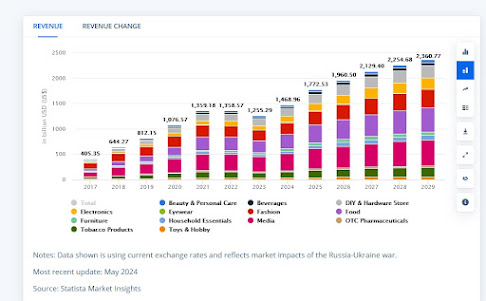E-commerce in China in 2024: Top Trends from Agencies
As we advance into 2024, China's e-commerce landscape continues to evolve at a rapid pace. Agencies and industry analysts have identified several key trends that are shaping the future of online shopping in the world's largest e-commerce market. These trends reflect changes in consumer behavior, technological advancements, and regulatory environments. Revenue in the eCommerce Market is projected to reach US$1,469.00bn in 2024
1. Livestreaming E-commerce Dominance
Livestreaming has revolutionized e-commerce in China, blending entertainment with instant purchasing options. In 2024, this trend continues to dominate, with influencers and brands using platforms like Taobao Live, Douyin (TikTok's Chinese counterpart), and Kuaishou to engage directly with consumers. Livestreaming is not just a sales channel; it has become a crucial tool for brand building and product launches.
read more
https://www.linkedin.com/pulse/chinese-ecommerce-market-driven-technological-advancements-cyw9e/
2. Integration of AI and AR Technologies
Artificial Intelligence (AI) and Augmented Reality (AR) are being increasingly integrated into the e-commerce experience to enhance customer engagement and satisfaction. AI is used for personalized recommendations, customer service, and inventory management, while AR allows consumers to visualize products in their own environment before purchasing. This technology is particularly prevalent in the fashion and home decor sectors.
3. Consumerism is changing
Sustainability is becoming a significant factor in consumer purchasing decisions. Chinese consumers are increasingly drawn to brands that demonstrate environmental responsibility. In response, e-commerce platforms and sellers are adopting eco-friendly practices such as sustainable packaging, carbon-neutral shipping options, and promoting eco-friendly products.
4. Cross-Border E-commerce Expansion
With the relaxation of certain international trade barriers and improvements in logistics, cross-border e-commerce is experiencing significant growth. Chinese consumers are increasingly purchasing international brands and products online, driven by a desire for quality and authenticity. Platforms like Alibaba’s Tmall Global douyin and JD Worldwide are expanding their international offerings to meet this demand.read more https://marketingtochina.com/guide-ecommerce-china/

5. Social Commerce Surge
Social commerce, which involves purchasing products directly through social media platforms, continues to surge. Platforms like WeChat, Douyin, and Xiaohongshu (Little Red Book) are making it easier for users to buy products without leaving the app, leveraging social recommendations and community engagements to drive sales.
6. Localized and Hyper-Personalized Marketing
E-commerce giants are focusing on hyper-localized and personalized marketing strategies. Using data analytics, companies can tailor their marketing campaigns to individual preferences and regional characteristics, increasing conversion rates. Personalization extends beyond marketing into customizing product offerings and shopping experiences.
7. Regulatory Adjustments
The Chinese government is tightening regulations around e-commerce to protect consumers and ensure fair competition. New regulations focus on data security, consumer privacy, and anti-competitive practices. Companies operating in China are adapting by enhancing their compliance structures and transparency.
8. Rise of Niche Platforms
While major platforms like Alibaba and JD.com continue to dominate, niche e-commerce platforms are gaining traction by catering to specific interests and demographics, such as luxury goods, second-hand markets, and specialty foods. These platforms often provide a curated experience that appeals to particular consumer segments.


Aucun commentaire:
Enregistrer un commentaire